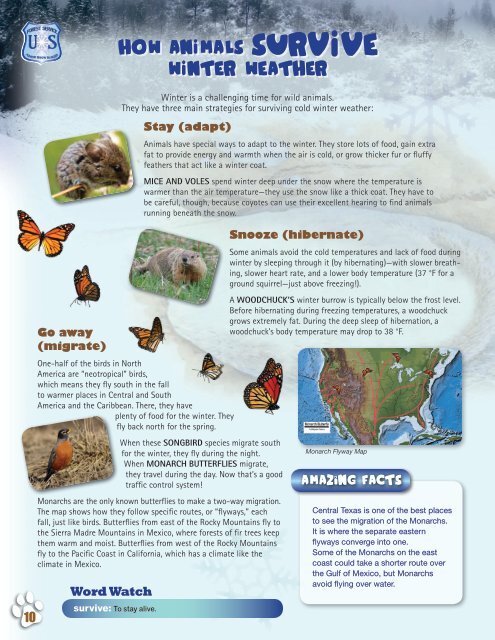The Science of Snow Meet Cutler, the Avalanche Rescue Dog ...
The Science of Snow Meet Cutler, the Avalanche Rescue Dog ...
The Science of Snow Meet Cutler, the Avalanche Rescue Dog ...
Create successful ePaper yourself
Turn your PDF publications into a flip-book with our unique Google optimized e-Paper software.
10<br />
Go away<br />
(migrate)<br />
Word Watch<br />
survive: To stay alive.<br />
Winter is a challenging time for wild animals.<br />
<strong>The</strong>y have three main strategies for surviving cold winter wea<strong>the</strong>r:<br />
Stay (adapt)<br />
One-half <strong>of</strong> <strong>the</strong> birds in North<br />
America are “neotropical” birds,<br />
which means <strong>the</strong>y fly south in <strong>the</strong> fall<br />
to warmer places in Central and South<br />
America and <strong>the</strong> Caribbean. <strong>The</strong>re, <strong>the</strong>y have<br />
plenty <strong>of</strong> food for <strong>the</strong> winter. <strong>The</strong>y<br />
fly back north for <strong>the</strong> spring.<br />
Animals have special ways to adapt to <strong>the</strong> winter. <strong>The</strong>y store lots <strong>of</strong> food, gain extra<br />
fat to provide energy and warmth when <strong>the</strong> air is cold, or grow thicker fur or fluffy<br />
fea<strong>the</strong>rs that act like a winter coat.<br />
Mice anD voleS spend winter deep under <strong>the</strong> snow where <strong>the</strong> temperature is<br />
warmer than <strong>the</strong> air temperature—<strong>the</strong>y use <strong>the</strong> snow like a thick coat. <strong>The</strong>y have to<br />
be careful, though, because coyotes can use <strong>the</strong>ir excellent hearing to find animals<br />
running beneath <strong>the</strong> snow.<br />
When <strong>the</strong>se SonGBiRD species migrate south<br />
for <strong>the</strong> winter, <strong>the</strong>y fly during <strong>the</strong> night.<br />
When MonaRch ButteRFlieS migrate,<br />
<strong>the</strong>y travel during <strong>the</strong> day. Now that’s a good<br />
traffic control system!<br />
Monarchs are <strong>the</strong> only known butterflies to make a two-way migration.<br />
<strong>The</strong> map shows how <strong>the</strong>y follow specific routes, or “flyways,” each<br />
fall, just like birds. Butterflies from east <strong>of</strong> <strong>the</strong> Rocky Mountains fly to<br />
<strong>the</strong> Sierra Madre Mountains in Mexico, where forests <strong>of</strong> fir trees keep<br />
<strong>the</strong>m warm and moist. Butterflies from west <strong>of</strong> <strong>the</strong> Rocky Mountains<br />
fly to <strong>the</strong> Pacific Coast in California, which has a climate like <strong>the</strong><br />
climate in Mexico.<br />
Snooze (hibernate)<br />
Some animals avoid <strong>the</strong> cold temperatures and lack <strong>of</strong> food during<br />
winter by sleeping through it (by hibernating)—with slower breath -<br />
ing, slower heart rate, and a lower body temperature (37 °F for a<br />
ground squirrel—just above freezing!).<br />
A WooDchuck’S winter burrow is typically below <strong>the</strong> frost level.<br />
Before hibernating during freezing temperatures, a woodchuck<br />
grows extremely fat. During <strong>the</strong> deep sleep <strong>of</strong> hibernation, a<br />
woodchuck’s body temperature may drop to 38 °F.<br />
Monarch Flyway Map<br />
z<br />
Central Texas is one <strong>of</strong> <strong>the</strong> best places<br />
to see <strong>the</strong> migration <strong>of</strong> <strong>the</strong> Monarchs.<br />
It is where <strong>the</strong> separate eastern<br />
flyways converge into one.<br />
Some <strong>of</strong> <strong>the</strong> Monarchs on <strong>the</strong> east<br />
coast could take a shorter route over<br />
<strong>the</strong> Gulf <strong>of</strong> Mexico, but Monarchs<br />
avoid flying over water.

















